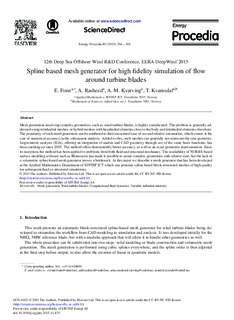| dc.contributor.author | Fonn, Eivind | |
| dc.contributor.author | Rasheed, Adil | |
| dc.contributor.author | Kvarving, Arne Morten | |
| dc.contributor.author | Kvamsdal, Trond | |
| dc.date.accessioned | 2018-01-18T06:32:52Z | |
| dc.date.available | 2018-01-18T06:32:52Z | |
| dc.date.created | 2015-12-09T17:56:55Z | |
| dc.date.issued | 2015 | |
| dc.identifier.citation | Energy Procedia. 2015, 80 294-301. | nb_NO |
| dc.identifier.issn | 1876-6102 | |
| dc.identifier.uri | http://hdl.handle.net/11250/2478061 | |
| dc.description.abstract | Mesh generation involving complex geometries, such as wind turbine blades, is highly complicated. The problem is generally addressed using tetrahedral meshes, or hybrid meshes with hexahedral elements close to the body and tetrahedral elements elsewhere. The popularity of such mesh generators can be attributed to their associated ease of use and relative eutomation, which comes at the cost of numerical accuracy in the subsequent analysis. Added to this, such meshes can generally not represent the true geometry. Isogeometric analysis (IGA), offering an integration of analsis and CAD geometry through use of the same basis functions, has been catching up since 2005. The method offers demonstrably better accuracy, as well as an exact geometric representation. Since its inception, the method has been applied to problems from both fluid and structural mechanics. The availability of NURBS-based surface modeling software such as Rhinoceros has made it possible to create complex geometries with relative ease, but the lack of a volumetric spline-based mesh generator proves a bottleneck. In this paper we describe a mesh generator that has been developed at the Applied Mathematics Department of SINTEF ICT which can generate spline based block structured meshes of high quality for subsequent fluid or structural simulations. | nb_NO |
| dc.language.iso | eng | nb_NO |
| dc.rights | Attribution-NonCommercial-NoDerivatives 4.0 Internasjonal | * |
| dc.rights.uri | http://creativecommons.org/licenses/by-nc-nd/4.0/deed.no | * |
| dc.title | Spline based Mesh Generator for high fidelity simulation of flow around turbine blades | nb_NO |
| dc.type | Journal article | nb_NO |
| dc.type | Peer reviewed | nb_NO |
| dc.description.version | publishedVersion | nb_NO |
| dc.source.pagenumber | 294-301 | nb_NO |
| dc.source.volume | 80 | nb_NO |
| dc.source.journal | Energy Procedia | nb_NO |
| dc.identifier.doi | 10.1016/j.egypro.2015.11.433 | |
| dc.identifier.cristin | 1298993 | |
| dc.relation.project | Norges forskningsråd: 216465 | nb_NO |
| dc.relation.project | Norges forskningsråd: 193823 | nb_NO |
| cristin.unitcode | 7401,90,11,0 | |
| cristin.unitname | Anvendt matematikk | |
| cristin.ispublished | true | |
| cristin.fulltext | original | |
| cristin.qualitycode | 1 | |

